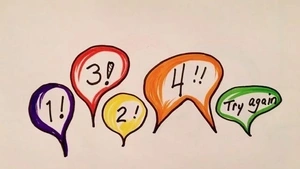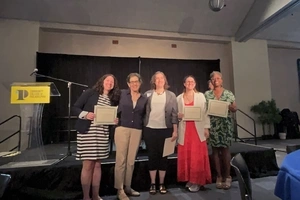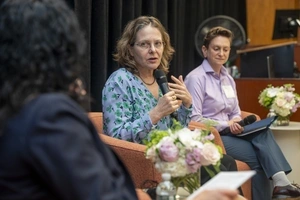Faculty Expert
-
Patrick Sexton
Assistant Dean of Educator Preparation and Undergraduate Programs
Learning, Teaching, and Literacies Division
Several years ago, on one of the first warm days of spring, Ms. Herrmann's third grade class came in from recess with more energy and excitement than she'd seen since the holiday break. She knew she'd need something to help them focus and transition to the afternoon math lesson. She dimmed the lights and asked everyone to "go to neutral." The students knew this was a cue that a game was about to begin.
"Excellent. We are going to do a few quick rounds of Collective Counts to get us ready for math. Do we need a reminder of the rules for Collective Counts?" In response an immediate silence fell across the room and all of the students closed their eyes or tipped their heads toward the ground. No one needed a reminder. They were ready to go. Someone started:
"One" "Two" "Three"
Pause
"Four!" "Four!"
The class momentarily filled with "Aww," and "No," then just as quickly returned to silence.
Someone started:
"One" "Two" "Three"
Pause
"Four" "Five" "Six" "Seven" "Seven" "Awww"
Someone started:
"One" "Two"...
After a few more rounds the class got all the way up to twenty. In a matter of five minutes the class was transformed, ready for the afternoon lesson.
Theater is an invaluable teaching tool in English literature classrooms. Teaching Shakespeare, for example, is often complemented by watching an interpretation of his work so that students can observe and appreciate the play as a theatrical piece and not just a written piece of literature.
But beyond literature and theater classrooms, theatrical techniques can be used in service of other learning goals, says Patrick Sexton, Executive Director of Teacher Education Programs at Penn GSE. Teachers can use theatrical techniques to establish and support classroom routines, or in service of specific academic learning objectives. Theatrical techniques are often movement-based but also focus on attention and communication. This makes them easily adaptable for teachers who are teaching remotely.
Sexton offers three key tips on how to incorporate techniques from the theater (like the games demonstrated by Portland Stage, Barbican Theatre, and Alliance Theatre) to help you reach your classroom goals, be they routines or learning goals.
Identify a clear goal
Before incorporating theater techniques into your classroom, ask yourself why you want to. It’s not something you should do just because, Sexton says, but it doesn’t have to be complex. Your goal can be learning oriented or focused on norms and routines – or even just to build community.
Ask yourself, “what concept do I have trouble getting kids to understand?” Then think about how physicalizing that concept might help your students to gain a deeper understanding. For example, if you’re trying to teach the concept of setting in literature, consider how your students can use their bodies in the space to set the scene for the story you will be reading in class. You might have students move through space. Have everyone walk around the room and give them prompts such as “Now we’re going to walk through sand. What does that feel like in your feet? We are walking through the wind… what does this have to do with the story?” By having students move and use their imaginations, teachers can explain setting in a way that is tangible.
Alternatively, maybe your learning goal is to get students to work together more effectively. How can you use theater techniques to shake up the ways they work together, their concepts of one another, or their concept around teamwork? Let’s say you really want your class to get better at teamwork and relying on each other. Doing collective counts, where they have to work together to reach a goal, can be a useful teaching tool. In collective counts (introduced in the story above), students work together to count up from the number 1, but no one is assigned to numbers and they have to pay attention to one another to non-verbally decide who goes next; if two people speak at the same time, start over. Games like collective counts can easily be played on Zoom since students don’t need to be able to move around.
Establish trust
Knowing the comfort level of your students (and yourself) is critical to successfully use theater tools in your classroom. If you choose a game that you aren’t comfortable facilitating or students are uncomfortable participating in, the likelihood of success is slim, and you might give up entirely.
One low-stakes way to incorporate movement is a simple game called Shaping Space. For example, you might reinforce the concept of proportions by having your students split up into groups of 1/3 and 2/3 of the class. The only instruction they get is the proportions – it’s up to them to figure out how to do it. By slowly introducing different theater games (like this one, or collective counts), you build your students’ comfort in a natural way that ultimately lets you play more challenging games with them or build assignments that also use performance. But without the scaffolding and trust building, students might balk at these opportunities.
This can be particularly tricky for teachers who are leading Zoom classrooms. Theater games can be used to get students engaged and can be adjusted for kids who need to keep their cameras off. Some games don’t require the use of cameras; for those that do, students who do not turn their cameras on can also play timekeeper or judge, allowing them to participate without having to turn their cameras on. Sexton suggests breaking students up into small groups first where they might be more comfortable with camera-on games and rotating between them. This will begin to build students’ comfort with playing games, enabling you as a teacher to facilitate a larger-group game on Zoom in time.
Find a buddy
Trying something new that takes you to the edge of your comfort zone can be hard. Sexton recommends finding another teacher who might want to go out on the limb with you. Holding one another accountable can help you push through any discomfort. Who can you share this idea with? Maybe the teacher next door used to be a dancer, or your department team is looking for new ways to address a sticky learning topic. These people can provide community where you can think through challenges together.

Subscribe to the Educator's Playbook
Get the latest release of the Educator's Playbook delivered straight to your inbox.
Media Inquiries
Penn GSE Communications is here to help reporters connect with the education experts they need.










